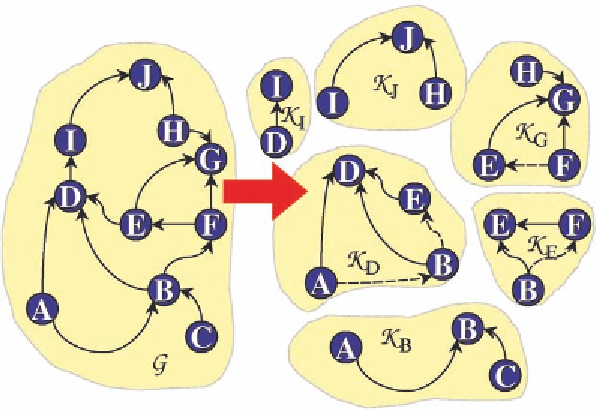Information Technology Reference
In-Depth Information
Separating Causal f unction Kernels from Causal Strategy Models
Since the universal approximation property has been proved for numerous of types of ANNs, this ap-
proach focuses on the construction of MLPs out of empirically proven cause-and-effect hypotheses.
Therefore the causal strategy model has to be separated into causal function kernels (CFK). The lat-
ter describes a set of variables and interjacent cause-and-effect relations, each of which consists of a
dependent element and its direct predecessors. Therefore the number of CFKs derived from a causal
strategy model corresponds to the number of contained variables which show an empirically significant
influence by other elements. Following the theory underlying this approach, the total cause-and-effect
relations within a causal function kernel represent the unknown causal function determining the values
of the dependent variable. Taking the above discussion into account, this function can be approximated
sufficiently accurate by an MLP with the appropriate time series of the independent variables as input
and those of the dependent element as output node.
Due to the possible existence of indirect associations between independent and dependent variables
within a CFK it is likely that the overall effect between such two elements has to be separated in order
to obtain the direct share of influence. This effect is called multicollinearity in the appropriate statisti-
cal literature and perturbs the approximation quality if it remains unsolved. Hence it is necessary to
extend the causal function kernels for cause-and-effect relations which directly and/or indirectly link
two independent variables
X
1
→ X
2
and consequently induce an indirect effect between
X
1
and the de-
pendent variable
Y
. These auxiliary cause-and-effect relations accounting for multicollinearity can be
discovered by analyzing the transitive closure
5
of each independent variable within the global causal
system: For every pair of independent variables
X
i
and
X
j
within a causal function kernel
K
Y
there exists
an auxiliary cause-and-effect relation
X
i
X
j
if and only if
X
j
is contained in the transitive closure of
X
i
according to the global model
G
. The procedure to construct extended causal function kernels (eCFK)
from a causally proven global strategy model
G
is shown in Figure 3.
Figure 3. Separation of (extended) causal function kernels

Search WWH ::

Custom Search